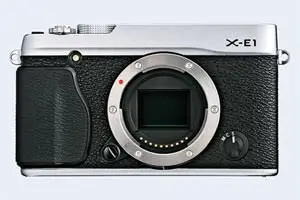Fujifilm X-E1 vs X-M1
The Fujifilm X-E1 and the Fujifilm X-M1 are two digital cameras that were announced, respectively, in September 2012 and June 2013. Both the X-E1 and the X-M1 are mirrorless interchangeable lens cameras that are equipped with an APS-C sensor. Both cameras offer a resolution of 16 megapixels.
Below is an overview of the main specs of the two cameras as a starting point for the comparison.

Check X-E1 offers at
ebay.com

Check X-M1 offers at
ebay.com
Going beyond this snapshot of core features and characteristics, what are the differences between the Fujifilm X-E1 and the Fujifilm X-M1? Which one should you buy? Read on to find out how these two cameras compare with respect to their body size, their imaging sensors, their shooting features, their input-output connections, and their reception by expert reviewers.
Body comparison
An illustration of the physical size and weight of the Fujifilm X-E1 and the Fujifilm X-M1 is provided in the side-by-side display below. The two cameras are presented according to their relative size. Three consecutive perspectives from the front, the top, and the back are available. All width, height and depth dimensions are rounded to the nearest millimeter.
The X-E1 can be obtained in two different colors (black, silver), while the X-M1 is available in three color-versions (black, silver, brown).
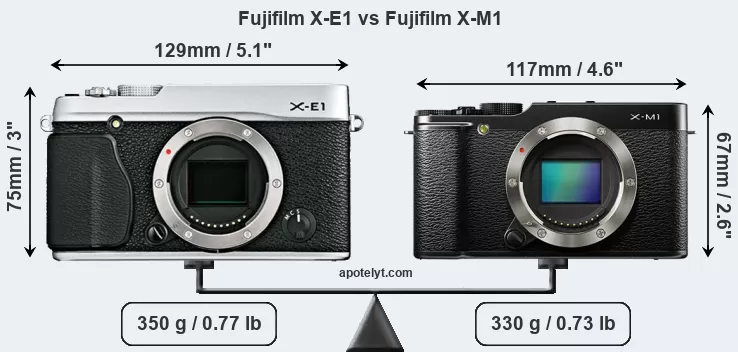

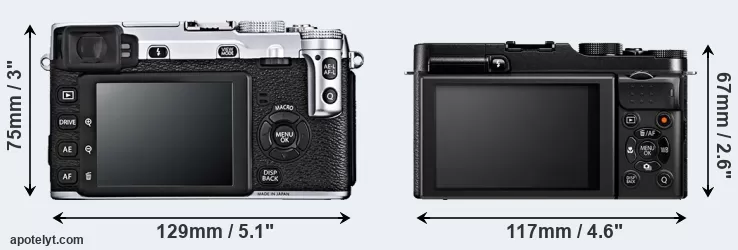
If the front view area (width x height) of the cameras is taken as an aggregate measure of their size, the Fujifilm X-M1 is notably smaller (19 percent) than the Fujifilm X-E1. Moreover, the X-M1 is markedly lighter (6 percent) than the X-E1. In this context, it is worth noting that neither the X-E1 nor the X-M1 are weather-sealed.
The above size and weight comparisons are to some extent incomplete since they do not consider the interchangeable lenses that both of these cameras require. In this particular case, both cameras feature the same lens mount, so that they can use the same lenses. You can compare the optics available in the Fujinon X Lens Catalog. Mirrorless cameras, such as the two under consideration, have the additional advantage of having a short flange to focal plane distance, which makes it possible to mount many lenses from other systems onto the camera via adapters.
The following table provides a synthesis of the main physical specifications of the two cameras and other similar ones. If you want to switch the focus of the display and review another camera pair, you can move across to the CAM-parator tool and choose from the broad selection of possible camera comparisons there.

| Camera Model |
Camera Width |
Camera Height |
Camera Depth |
Camera Weight |
Battery Life |
Weather Sealing |
Camera Launch |
Launch Price |
Street Price |
||
|---|---|---|---|---|---|---|---|---|---|---|---|
| 1. | Fujifilm X-E1 | 129 mm | 75 mm | 38 mm | 350 g | 350 | n | Sep 2012 | US$ 999 | ebay.com | |
| 2. | Fujifilm X-M1 | 117 mm | 67 mm | 39 mm | 330 g | 350 | n | Jun 2013 | US$ 699 | ebay.com | |
| 3. | Fujifilm X-A1 | 117 mm | 67 mm | 39 mm | 330 g | 350 | n | Sep 2013 | US$ 399 | ebay.com | |
| 4. | Fujifilm X-A2 | 117 mm | 67 mm | 40 mm | 350 g | 410 | n | Jan 2015 | US$ 399 | ebay.com | |
| 5. | Fujifilm X-A10 | 117 mm | 67 mm | 40 mm | 331 g | 410 | n | Dec 2016 | US$ 399 | ebay.com | |
| 6. | Fujifilm X-E2 | 129 mm | 75 mm | 37 mm | 350 g | 350 | n | Oct 2013 | US$ 999 | ebay.com | |
| 7. | Fujifilm X-E2S | 129 mm | 75 mm | 37 mm | 350 g | 350 | n | Jan 2016 | US$ 699 | ebay.com | |
| 8. | Fujifilm X-E3 | 121 mm | 74 mm | 43 mm | 337 g | 350 | n | Sep 2017 | US$ 899 | ebay.com | |
| 9. | Fujifilm X-Pro1 | 140 mm | 82 mm | 43 mm | 450 g | 300 | n | Jan 2012 | US$ 1 699 | ebay.com | |
| 10. | Fujifilm X-T10 | 118 mm | 83 mm | 41 mm | 381 g | 350 | n | May 2015 | US$ 799 | ebay.com | |
| 11. | Fujifilm X-T20 | 118 mm | 83 mm | 41 mm | 383 g | 350 | n | Jan 2017 | US$ 899 | ebay.com | |
| 12. | Sony NEX-6 | 120 mm | 67 mm | 43 mm | 345 g | 360 | n | Sep 2012 | US$ 999 | ebay.com | |
| Note: Measurements and pricing do not include easily detachable parts, such as add-on or interchangeable lenses or optional viewfinders. | |||||||||||
Any camera decision will obviously take relative prices into account. The retail prices at the time of the camera’s release place the model in the market relative to other models in the producer’s line-up and the competition. The X-M1 was launched at a markedly lower price (by 30 percent) than the X-E1, which puts it into a different market segment. Usually, retail prices stay at first close to the launch price, but after several months, discounts become available. Later in the product cycle and, in particular, when the replacement model is about to appear, further discounting and stock clearance sales often push the camera price considerably down. Then, after the new model is out, very good deals can frequently be found on the pre-owned market.
Sensor comparison
The size of the sensor inside a digital camera is one of the key determinants of image quality. A large sensor will tend to have larger individual pixels that provide better low-light sensitivity, wider dynamic range, and richer color-depth than smaller pixel-units in a sensor of the same technological generation. Furthermore, a large sensor camera will give the photographer more possibilities to use shallow depth-of-field in order to isolate a subject from the background. On the downside, larger sensors tend to be associated with larger, more expensive camera bodies and lenses.
Both cameras under consideration feature an APS-C sensor and have a format factor (sometimes also referred to as "crop factor") of 1.5. Within the spectrum of camera sensors, this places the review cameras among the medium-sized sensor cameras that aim to strike a balance between image quality and portability. Both cameras have a native aspect ratio (sensor width to sensor height) of 3:2.
Technology-wise, the X-M1 uses a more advanced image processing engine (EXR Processor II) than the X-E1 (EXR Processor), with benefits for noise reduction, color accuracy, and processing speed.
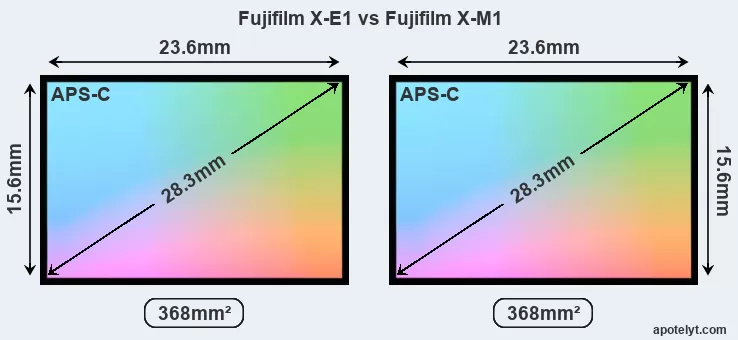
The two cameras under review do not only share the same sensor size, but also offer an identical resolution of 16 megapixels. This similarity in sensor specs implies that both the X-E1 and the X-M1 have the same pixel density, as well as the same pixel size. It should, however, be noted that the X-M1 is a somewhat more recent model (by 9 months) than the X-E1, and its sensor might have benefitted from technological advances during this time. Coming back to sensor resolution, it should be mentioned that neither of the two cameras has an anti-alias filter installed, so they are able to capture all the detail the sensor resolves.
The Fujifilm X-E1 has a native sensitivity range from ISO 200 to ISO 6400, which can be extended to ISO 100-25600. The Fujifilm X-M1 offers exactly the same ISO settings.
Technology-wise, both cameras are equipped with CMOS (Complementary Metal–Oxide–Semiconductor) sensors. Both cameras use the X-Trans layout of photosites, which according to Fujifilm helps to minimize moiré.
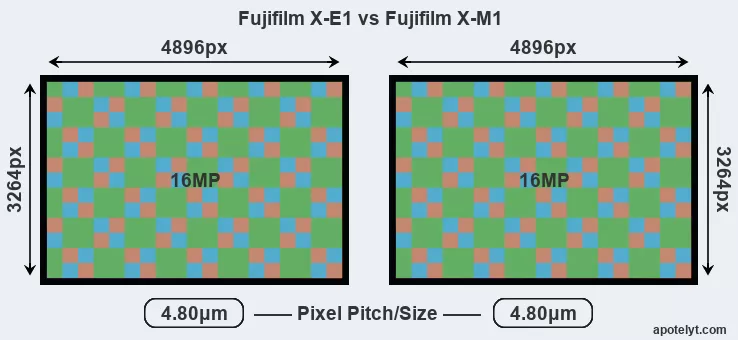
For many cameras, data on sensor performance has been reported by DXO Mark. This service assesses and scores the color depth ("DXO Portrait"), dynamic range ("DXO Landscape"), and low-light sensitivity ("DXO Sports") of camera sensors, and also publishes an overall camera score. The adjacent table reports on the physical sensor characteristics and the outcomes of the DXO sensor quality tests for a sample of comparator-cameras.

| Camera Model |
Sensor Class |
Resolution (MP) |
Horiz. Pixels |
Vert. Pixels |
Video Format |
DXO Portrait |
DXO Landscape |
DXO Sports |
DXO Overall |
||
|---|---|---|---|---|---|---|---|---|---|---|---|
| 1. | Fujifilm X-E1 | APS-C | 16.0 | 4896 | 3264 | 1080/24p | 23.2 | 12.4 | 1298 | 75 | |
| 2. | Fujifilm X-M1 | APS-C | 16.0 | 4896 | 3264 | 1080/30p | 23.4 | 12.6 | 1371 | 76 | |
| 3. | Fujifilm X-A1 | APS-C | 16.0 | 4896 | 3264 | 1080/30p | 23.4 | 12.6 | 1390 | 76 | |
| 4. | Fujifilm X-A2 | APS-C | 16.0 | 4896 | 3264 | 1080/30p | 23.6 | 12.8 | 1515 | 79 | |
| 5. | Fujifilm X-A10 | APS-C | 16.0 | 4896 | 3264 | 1080/30p | 23.9 | 13.2 | 1691 | 81 | |
| 6. | Fujifilm X-E2 | APS-C | 16.0 | 4896 | 3264 | 1080/60p | 23.4 | 12.6 | 1400 | 77 | |
| 7. | Fujifilm X-E2S | APS-C | 16.0 | 4896 | 3264 | 1080/60p | 23.7 | 13.0 | 1608 | 80 | |
| 8. | Fujifilm X-E3 | APS-C | 24.0 | 6000 | 4000 | 4K/30p | 23.9 | 13.3 | 1764 | 82 | |
| 9. | Fujifilm X-Pro1 | APS-C | 16.0 | 4896 | 3264 | 1080/24p | 23.1 | 12.3 | 1238 | 74 | |
| 10. | Fujifilm X-T10 | APS-C | 16.0 | 4896 | 3264 | 1080/60p | 23.7 | 12.9 | 1546 | 79 | |
| 11. | Fujifilm X-T20 | APS-C | 24.0 | 6000 | 4000 | 4K/30p | 23.9 | 13.2 | 1704 | 81 | |
| 12. | Sony NEX-6 | APS-C | 16.0 | 4912 | 3264 | 1080/60i | 23.7 | 13.1 | 1018 | 78 | |
| Note: DXO values in italics represent estimates based on sensor size and age. | |||||||||||
Many modern cameras cannot only take still pictures, but also record videos. Both cameras under consideration have a sensor with sufficiently fast read-out times for moving pictures, but the X-M1 provides a faster frame rate than the X-E1. It can shoot movie footage at 1080/30p, while the X-E1 is limited to 1080/24p.
Feature comparison
Beyond body and sensor, cameras can and do differ across a range of features. For example, the X-E1 has an electronic viewfinder (2360k dots), which can be very helpful when shooting in bright sunlight. In contrast, the X-M1 relies on live view and the rear LCD for framing. The following table reports on some other key feature differences and similarities of the Fujifilm X-E1, the Fujifilm X-M1, and comparable cameras.

| Camera Model |
Viewfinder (Type or 000 dots) |
Control Panel (yes/no) |
LCD Specifications (inch/000 dots) |
LCD Attach- ment |
Touch Screen (yes/no) |
Max Shutter Speed * |
Max Shutter Flaps * |
Built-in Flash (yes/no) |
Built-in Image Stab |
||
|---|---|---|---|---|---|---|---|---|---|---|---|
| 1. | Fujifilm X-E1 | 2360 | n | 2.8 / 460 | fixed | n | 1/4000s | 6.0/s | Y | n | |
| 2. | Fujifilm X-M1 | none | n | 3.0 / 920 | tilting | n | 1/4000s | 5.6/s | Y | n | |
| 3. | Fujifilm X-A1 | none | n | 3.0 / 920 | tilting | n | 1/4000s | 5.6/s | Y | n | |
| 4. | Fujifilm X-A2 | none | n | 3.0 / 920 | tilting | n | 1/4000s | 5.6/s | Y | n | |
| 5. | Fujifilm X-A10 | none | n | 3.0 / 1040 | tilting | n | 1/4000s | 6.0/s | Y | n | |
| 6. | Fujifilm X-E2 | 2360 | n | 3.0 / 1040 | fixed | n | 1/4000s | 7.0/s | Y | n | |
| 7. | Fujifilm X-E2S | 2360 | n | 3.0 / 1040 | fixed | n | 1/4000s | 7.0/s | Y | n | |
| 8. | Fujifilm X-E3 | 2360 | n | 3.0 / 1040 | fixed | Y | 1/4000s | 8.0/s | n | n | |
| 9. | Fujifilm X-Pro1 | 1440 | n | 3.0 / 1230 | fixed | n | 1/4000s | 6.0/s | n | n | |
| 10. | Fujifilm X-T10 | 2360 | n | 3.0 / 920 | tilting | n | 1/4000s | 8.0/s | Y | n | |
| 11. | Fujifilm X-T20 | 2360 | n | 3.0 / 1040 | tilting | Y | 1/4000s | 8.0/s | Y | n | |
| 12. | Sony NEX-6 | 2359 | n | 3.0 / 921 | tilting | n | 1/4000s | 10.0/s | Y | n | |
| Note: *) Information refers to the mechanical shutter, unless the camera only has an electronic one. | |||||||||||
Concerning the storage of imaging data, both the X-E1 and the X-M1 write their files to SDXC cards. Both cameras can use UHS-I cards, which provide for Ultra High Speed data transfer of up to 104 MB/s.
Connectivity comparison
For some imaging applications, the extent to which a camera can communicate with its environment can be an important aspect in the camera decision process. The table below provides an overview of the connectivity of the Fujifilm X-E1 and Fujifilm X-M1 and, in particular, the interfaces the cameras (and selected comparators) provide for accessory control and data transfer.

| Camera Model |
Hotshoe Port |
Internal Mic / Speaker |
Microphone Port |
Headphone Port |
HDMI Port |
USB Port |
WiFi Support |
NFC Support |
Bluetooth Support |
||
|---|---|---|---|---|---|---|---|---|---|---|---|
| 1. | Fujifilm X-E1 | Y | stereo / mono | Y | - | mini | 2.0 | - | - | - | |
| 2. | Fujifilm X-M1 | Y | stereo / mono | - | - | mini | 2.0 | Y | - | - | |
| 3. | Fujifilm X-A1 | Y | stereo / mono | - | - | mini | 2.0 | Y | - | - | |
| 4. | Fujifilm X-A2 | Y | stereo / mono | - | - | mini | 2.0 | Y | - | - | |
| 5. | Fujifilm X-A10 | - | stereo / mono | - | - | micro | 2.0 | Y | - | - | |
| 6. | Fujifilm X-E2 | Y | stereo / mono | Y | - | micro | 2.0 | Y | - | - | |
| 7. | Fujifilm X-E2S | Y | stereo / mono | Y | - | micro | 2.0 | Y | - | - | |
| 8. | Fujifilm X-E3 | Y | stereo / mono | Y | - | micro | 2.0 | Y | - | Y | |
| 9. | Fujifilm X-Pro1 | Y | stereo / mono | - | - | mini | 2.0 | - | - | - | |
| 10. | Fujifilm X-T10 | Y | stereo / mono | Y | - | micro | 2.0 | Y | - | - | |
| 11. | Fujifilm X-T20 | Y | stereo / mono | Y | - | micro | 2.0 | Y | - | - | |
| 12. | Sony NEX-6 | Y | stereo / mono | - | - | mini | 2.0 | Y | - | - |
It is notable that the X-E1 has a microphone port, which is missing on the X-M1. Such an external microphone input can help to substantially improve the quality of audio recordings when a good external microphone is used.
Both the X-E1 and the X-M1 have been discontinued, but can regularly be found used on ebay. The X-E1 was replaced by the Fujifilm X-E2, while the X-M1 does not have a direct successor. Further information on the features and operation of the X-E1 and X-M1 can be found, respectively, in the Fujifilm X-E1 Manual (free pdf) or the online Fujifilm X-M1 Manual.
Review summary
So what conclusions can be drawn? Which of the two cameras – the Fujifilm X-E1 or the Fujifilm X-M1 – has the upper hand? Is one clearly better than the other? A synthesis of the relative strong points of each of the models is listed below.
Arguments in favor of the Fujifilm X-E1:
- Better sound: Can connect to an external microphone for higher quality sound recording.
- Easier framing: Has an electronic viewfinder for image composition and settings control.
- More heavily discounted: Has been on the market for longer (launched in September 2012).
Reasons to prefer the Fujifilm X-M1:
- Better jpgs: Has a more modern image processing engine (EXR Processor II vs EXR Processor).
- Better video: Provides higher movie framerates (1080/30p versus 1080/24p).
- Larger screen: Has a bigger rear LCD (3.0" vs 2.8") for image review and settings control.
- More detailed LCD: Has a higher resolution rear screen (920k vs 460k dots).
- More flexible LCD: Has a tilting screen for odd-angle shots in landscape orientation.
- More compact: Is smaller (117x67mm vs 129x75mm) and will fit more readily into a bag.
- Easier file upload: Has wifi built in for automatic backup or image transfer to the web.
- More affordable: Was introduced into a lower priced category (30 percent cheaper at launch).
- More modern: Was introduced somewhat (9 months) more recently.
If the number of relative strengths (bullet points above) is taken as a guide, the X-M1 is the clear winner of the contest (9 : 3 points). However, the relevance of individual strengths will vary across photographers, so that you might want to apply your own weighing scheme to the summary points when reflecting and deciding on a new camera. A professional wedding photographer will view the differences between cameras in a way that diverges from the perspective of a travel photog, and a person interested in cityscapes has distinct needs from a macro shooter. Hence, the decision which camera is best and worth buying is often a very personal one.
How about other alternatives? Do the specifications of the Fujifilm X-E1 and the Fujifilm X-M1 place the cameras among the top in their class? Find out in the latest Best Mirrorless Interchangeable Lens Camera listing whether the two cameras rank among the cream of the crop.
In any case, while the comparison of technical specifications can provide a useful overview of the capabilities of different cameras, it says little about, for example, the shooting experience and imaging performance of the X-E1 and the X-M1 in practical situations. User reviews, such as those found at amazon, can sometimes inform about these issues, but such feedback is often incomplete, inconsistent, and biased.
Expert reviews
This is why expert reviews are important. The table below provides a synthesis of the camera assessments of some of the best known photo-gear review sites (amateurphotographer [AP], cameralabs [CL], digitalcameraworld [DCW], dpreview [DPR], ephotozine [EPZ], photographyblog [PB]). As can be seen, the professional reviewers agree in many cases on the quality of different cameras, but sometimes their assessments diverge, reinforcing the earlier point that a camera decision is often a very personal choice.

| Camera Model |
AP score |
CL score |
DCW score |
DPR score |
EPZ score |
PB score |
Camera Launch |
Launch Price |
Street Price |
||
|---|---|---|---|---|---|---|---|---|---|---|---|
| 1. | Fujifilm X-E1 | 4/5 | + + | .. | 79/100 | 4.5/5 | 4.5/5 | Sep 2012 | US$ 999 | ebay.com | |
| 2. | Fujifilm X-M1 | 3/5 | + | .. | 77/100 | 4.5/5 | 4.5/5 | Jun 2013 | US$ 699 | ebay.com | |
| 3. | Fujifilm X-A1 | .. | .. | .. | .. | 4.5/5 | 4.5/5 | Sep 2013 | US$ 399 | ebay.com | |
| 4. | Fujifilm X-A2 | 4/5 | .. | .. | .. | 4.5/5 | 4.5/5 | Jan 2015 | US$ 399 | ebay.com | |
| 5. | Fujifilm X-A10 | .. | .. | .. | .. | 4/5 | 4/5 | Dec 2016 | US$ 399 | ebay.com | |
| 6. | Fujifilm X-E2 | 4/5 | .. | .. | 80/100 | 4.5/5 | 5/5 | Oct 2013 | US$ 999 | ebay.com | |
| 7. | Fujifilm X-E2S | 4.5/5 | .. | .. | 77/100 | 4.5/5 | 4.5/5 | Jan 2016 | US$ 699 | ebay.com | |
| 8. | Fujifilm X-E3 | 4.5/5 | + | 4.5/5 | 84/100 | 4.5/5 | 4.5/5 | Sep 2017 | US$ 899 | ebay.com | |
| 9. | Fujifilm X-Pro1 | 5/5 | + + | .. | 79/100 | 4.5/5 | 4.5/5 | Jan 2012 | US$ 1 699 | ebay.com | |
| 10. | Fujifilm X-T10 | 4.5/5 | + + | .. | 80/100 | 5/5 | 5/5 | May 2015 | US$ 799 | ebay.com | |
| 11. | Fujifilm X-T20 | 5/5 | + + | 5/5 | 82/100 | 5/5 | 4.5/5 | Jan 2017 | US$ 899 | ebay.com | |
| 12. | Sony NEX-6 | 5/5 | + + | .. | 78/100 | 4.5/5 | 4.5/5 | Sep 2012 | US$ 999 | ebay.com | |
| Note: (+ +) highly recommended; (+) recommended; (o) reviewed; (..) not available. | |||||||||||
The review scores listed above should be treated with care, though. The assessments were made in relation to similar cameras of the same technological generation. Thus, a score needs to be put into the context of the launch date and the launch price of the camera, and rating-comparisons among cameras that span long time periods or concern very differently equipped models make little sense. Also, please note that some of the review sites have changed their methodology and reporting over time.

Check X-E1 offers at
ebay.com

Check X-M1 offers at
ebay.com
Other camera comparisons
Did this review help to inform your camera decision process? If you would like to see a different side-by-side camera review, just use the search menu below. There is also a set of direct links to comparison reviews that other users of the CAM-parator app explored.
- Canon 100D vs Fujifilm X-M1
- Canon 250D vs Fujifilm X-M1
- Canon 80D vs Fujifilm X-M1
- Canon SL2 vs Fujifilm X-M1
- Fujifilm GFX 50S vs Fujifilm X-E1
- Fujifilm X-A1 vs Fujifilm X-M1
- Fujifilm X-E1 vs Fujifilm X-E4
- Fujifilm X-E1 vs Fujifilm X100VI
- Fujifilm X-E1 vs Nikon D2Xs
- Fujifilm X-E1 vs Olympus E-M1X
- Fujifilm X-E1 vs Sony A77 II
- Fujifilm X-M1 vs Leica M Typ 262
Specifications: Fujifilm X-E1 vs Fujifilm X-M1
Below is a side-by-side comparison of the specs of the two cameras to facilitate a quick review of their differences and common features.
| Camera Model | Fujifilm X-E1 | Fujifilm X-M1 |
|---|---|---|
| Camera Type | Mirrorless system camera | Mirrorless system camera |
| Camera Lens | Fujifilm X mount lenses | Fujifilm X mount lenses |
| Launch Date | September 2012 | June 2013 |
| Launch Price | USD 999 | USD 699 |
| Sensor Specs | Fujifilm X-E1 | Fujifilm X-M1 |
| Sensor Technology | CMOS | CMOS |
| Sensor Format | APS-C Sensor | APS-C Sensor |
| Sensor Size | 23.6 x 15.6 mm | 23.6 x 15.6 mm |
| Sensor Area | 368.16 mm2 | 368.16 mm2 |
| Sensor Diagonal | 28.3 mm | 28.3 mm |
| Crop Factor | 1.5x | 1.5x |
| Sensor Resolution | 16 Megapixels | 16 Megapixels |
| Image Resolution | 4896 x 3264 pixels | 4896 x 3264 pixels |
| Pixel Pitch | 4.80 μm | 4.80 μm |
| Pixel Density | 4.34 MP/cm2 | 4.34 MP/cm2 |
| Moiré control | no AA filter | no AA filter |
| Movie Capability | 1080/24p Video | 1080/30p Video |
| ISO Setting | 200 - 6,400 ISO | 200 - 6,400 ISO |
| ISO Boost | 100 - 25,600 ISO | 100 - 25,600 ISO |
| Image Processor | EXR Processor | EXR Processor II |
| Screen Specs | Fujifilm X-E1 | Fujifilm X-M1 |
| Viewfinder Type | Electronic viewfinder | no viewfinder |
| Viewfinder Field of View | 100% | |
| Viewfinder Resolution | 2360k dots | |
| LCD Framing | Live View | Live View |
| Rear LCD Size | 2.8inch | 3.0inch |
| LCD Resolution | 460k dots | 920k dots |
| LCD Attachment | Fixed screen | Tilting screen |
| Shooting Specs | Fujifilm X-E1 | Fujifilm X-M1 |
| Focus System | Contrast-detect AF | Contrast-detect AF |
| Manual Focusing Aid | Focus Peaking | Focus Peaking |
| Max Shutter Speed (mechanical) | 1/4000s | 1/4000s |
| Continuous Shooting | 6 shutter flaps/s | 5.6 shutter flaps/s |
| Fill Flash | Built-in Flash | Built-in Flash |
| Storage Medium | SDXC cards | SDXC cards |
| Single or Dual Card Slots | Single card slot | Single card slot |
| UHS card support | UHS-I | UHS-I |
| Connectivity Specs | Fujifilm X-E1 | Fujifilm X-M1 |
| External Flash | Hotshoe | Hotshoe |
| USB Connector | USB 2.0 | USB 2.0 |
| HDMI Port | mini HDMI | mini HDMI |
| Microphone Port | External MIC port | no MIC socket |
| Wifi Support | no Wifi | Wifi built-in |
| Body Specs | Fujifilm X-E1 | Fujifilm X-M1 |
| Battery Type | Fujifilm NP-W126 | Fujifilm NP-W126 |
| Battery Life (CIPA) | 350 shots per charge | 350 shots per charge |
| Body Dimensions |
129 x 75 x 38 mm (5.1 x 3.0 x 1.5 in) |
117 x 67 x 39 mm (4.6 x 2.6 x 1.5 in) |
| Camera Weight | 350 g (12.3 oz) | 330 g (11.6 oz) |

Check X-E1 offers at
ebay.com

Check X-M1 offers at
ebay.com
Did you notice an error on this page? If so, please get in touch, so that we can correct the information.
